Characteristics and Rapid Prediction of Seismic Subsidence of Saturated Seabed Foundation with Interbedded Soft Clay–Sand
Abstract
1. Introduction
2. Geometric Model and Parameter Setting
2.1. Model Generation for Saturated Seabed Foundation with Interbedded Soft Clay–Sand
- (1)
- The first randomization process is to randomly generate 5 numbers, a, b, c, d, and e, in the interval range [0, 80] and simultaneously satisfy the following conditions: , , and . By this stochastic process, the seabed foundation with a thickness of 80 m can be randomly divided into 6 layers, and the thickness of each layer is between 2 m and 30 m, as shown in Figure 2a–c;
- (2)
- The second randomization process is to randomly select n () layers of soil out of the 6 layers, whose material properties are set as clay layer (M1), and the remaining 6 n layers are set as sandy soil layers (M2). See Figure 2d.
2.2. Constitutive Models and Validation
2.3. Parameter Settings
2.3.1. Parameters of the Constitutive Models
2.3.2. Seismic Wave Parameters
2.4. Boundary Conditions and Monitoring Points
3. Analysis and Discussion of Results
3.1. Initial State
3.2. Seismic Dynamic Response Characteristics
3.2.1. Acceleration and Displacement Response
3.2.2. Pore Pressure and Effective Stress Response
3.2.3. Assessment of Liquefaction Zones
3.3. Post-Earthquake Consolidation
3.3.1. Displacement
3.3.2. Pore Pressure
3.4. Statistics of 4000 Case Results
4. Rapid Prediction Model Based on Machine Learning Theory
4.1. Rapid Prediction Model for Seismic-Induced Subsidence of Seabed Foundation with Interbedded Soft Clay–Sand
4.2. Model Reliability Verification
5. Conclusions
- (1)
- A comparative analysis of the experimental and numerical simulation results confirmed that the Soft Clay and PZIII constitutive models integrated in FssiCAS effectively characterize the mechanical response of clay–sand composite soil foundations;
- (2)
- Under the sustained action of seismic loading, the pore water pressure within the saturated seabed foundations with interbedded soft clay–sand accumulates, while the effective stress decreases, leading to significant seabed softening. During the post-seismic consolidation phase, the settlement of the seabed foundation soil is pronounced, with settlements up to 0.8 m;
- (3)
- The settlement of the saturated seabed foundations with interbedded soft clay–sand under seismic loading is significantly affected by the PGA, clay layer thickness, and burial depth. The greater the PGA, the larger the seabed settlement; the shallower the burial depth of the clay layer, the greater the seabed settlement; and the higher the proportion of clay layer thickness, the greater the seabed settlement;
- (4)
- The Random Forest-based machine learning model can rapidly predict the seismic-induced settlement behavior of submarine foundations in soft clay–sand interlayers with a prediction accuracy of R2 = 0.91, which verifies its high reliability. This study provides a new technical path for the rapid prediction of the seismic settlement of submarine foundations in engineering. It also shows that physically constrained large-scale artificial intelligence models have broad application prospects in the field of engineering design, assessment, and prediction.
Author Contributions
Funding
Institutional Review Board Statement
Informed Consent Statement
Data Availability Statement
Conflicts of Interest
References
- Liu, Y.-X.; Guo, Y.; Huang, C. Comparative Study on the Development Situation and Policies of Offshore Wind Power in China and Abroad. Res. Sci. Technol. Manag. 2023, 43, 65–70. (In Chinese) [Google Scholar]
- Zhao, L.-Y.; Shan, Z.-G.; Wang, M.-Y. Analysis of Horizontal Ground Liquefaction Characteristics of South Yellow Sea Offshore Wind Farm under Earthquake Action. Geotech. Eng. Soil Mech. 2022, 43, 13. (In Chinese) [Google Scholar]
- Zhang, Z.; Li, Y.; Xu, C.; Du, X.; Dou, P.; Yan, G. Study on seismic failure mechanism of shallow buried underground frame structures based on dynamic centrifuge tests. Soil Dyn. Earthq. Eng. 2021, 150, 106938. [Google Scholar] [CrossRef]
- Zhou, Y.G.; Liu, K.; Sun, Z.B.; Chen, Y.M. Liquefaction mitigation mechanisms of stone column-improved ground by dynamic centrifuge model tests. Soil Dyn. Earthq. Eng. 2021, 150, 106946. [Google Scholar] [CrossRef]
- Li, L.-Y.; Rajesh, S.; Chen, J.-F. Centrifuge model tests on the deformation behavior of geosynthetic-encased stone column supported embankment under undrained condition. Geotext. Geomembr. 2021, 49, 550–563. [Google Scholar] [CrossRef]
- Maharjan, M.; Takahashi, A. Centrifuge model tests on liquefaction-induced settlement and pore water migration in non-homogeneous soil deposits. Soil Dyn. Earthq. Eng. 2013, 55, 161–169. [Google Scholar] [CrossRef]
- Higo, Y.; Lee, C.W.; Doi, T.; Kinugawa, T.; Kimura, M.; Kimoto, S.; Oka, F. Study of dynamic stability of unsaturated embankments with different water contents by centrifugal model tests. Soils Found. 2015, 55, 112–126. [Google Scholar] [CrossRef]
- Chakrabortty, P.; Popescu, R. Numerical simulation of centrifuge tests on homogeneous and heterogeneous soil models. Comput. Geotech. 2012, 41, 95–105. [Google Scholar] [CrossRef]
- Yu, H.-Y.; He, G.-N.; Yang, B. Experimental Study on the Seismic Settlement Characteristics of Soft Soils. J. Dalian Univ. 1996, 76–82. (In Chinese) [Google Scholar]
- Xie, W.; Zhang, Q.; Gao, B.; Ye, G.; Zhu, W.; Yang, Y. Shaking table tests for seismic response of jack-up platform with pile leg-mat foundation on sandy seabed. Ocean Eng. 2024, 309, 118564. [Google Scholar] [CrossRef]
- Tsaparli, V.; Kontoe, S.; Taborda, D.M.; Potts, D.M. Vertical ground motion and its effects on liquefaction resistance of fully saturated sand deposits. Proc. R. Soc. A Math. Phys. Eng. Sci. 2016, 472, 20160434. [Google Scholar] [CrossRef]
- Gu, L.; Zhang, F.; Bao, X.; Shi, Z.; Ye, G.; Ling, X. Seismic behavior of breakwaters on complex ground by numerical tests: Liquefaction and post liquefaction ground settlements. Earthq. Eng. Eng. Vib. 2018, 17, 325–342. [Google Scholar] [CrossRef]
- Gu, J.-R.; Li, P.; Tian, Z.-Y.; Zhou, C.-Z.; Zhang, Y. Study on the Influence of Earthquake Motion on the Seismic Settlement of Soft Soils Based on OpenSees. J. Earthq. Eng. 2019, 41, 1339–1346. (In Chinese) [Google Scholar]
- Gao, G.; Wang, X.; Zhu, T.; Liao, Y.; Tong, J. HSS Modeling and Stability Analysis of Single-Phase PFC Converters. In Proceedings of the 2022 IEEE Applied Power Electronics Conference and Exposition (APEC), Houston, TX, USA, 20–24 March 2022. [Google Scholar]
- Gao, B.; Ye, G.; Zhang, Q.; Xie, Y.; Yan, B. Numerical simulation of suction bucket foundation response located in liquefiable sand under earthquakes. Ocean Eng. 2021, 235, 109394. [Google Scholar] [CrossRef]
- Chen, W.; Huang, L.; Xu, L.; Zhao, K.; Wang, Z.; Jeng, D. Numerical study on the frequency response of offshore monopile foundation to seismic excitation. Comput. Geotech. 2021, 138, 104342. [Google Scholar] [CrossRef]
- Ye, J.; Jeng, D.; Wang, R.; Zhu, C. A 3-D semi-coupled numerical model for fluid–structures–seabed-interaction (FSSI-CAS 3D): Model and verification. J. Fluids Struct. 2013, 40, 148–162. [Google Scholar] [CrossRef]
- He, K.; Huang, T.; Ye, J. Stability analysis of a composite breakwater at Yantai port, China: An application of FSSI-CAS-2D. Ocean. Eng. 2018, 168, 95–107. [Google Scholar] [CrossRef]
- Jianhong, Y.; Dongsheng, J.; Liu, P.L.; Chan, A.H.; Ren, W.; Changqi, Z. Breaking wave-induced response of composite breakwater and liquefaction in seabed foundation. Coast. Eng. 2014, 85, 72–86. [Google Scholar] [CrossRef]
- Ye, J.; He, K. Dynamics of a pipeline buried in loosely deposited seabed to nonlinear wave & current. Ocean Eng. 2021, 232, 109127. [Google Scholar]
- Zhao, H.-B. Predictgaoion of Settlement in Soft Soil Subgrades of Highways. J. Undergr. Space Eng. 2005, 190–192. (In Chinese) [Google Scholar]
- Chen, X.-F.; Liu, L. Study on the Prediction Method of Settlement for Metro Tunnels Adjacent to Large Deep Excavations. Mod. Tunneling Technol. 2014, 51, 94–100. [Google Scholar]
- Ling, X.; Kong, X.; Tang, L.; Zhao, Y.; Tang, W.; Zhang, Y. Predicting earth pressure balance (EPB) shield tunneling-induced ground settlement in compound strata using random forest. Transp. Geotech. 2022, 35, 100771. (In Chinese) [Google Scholar] [CrossRef]
- Wang, X.; Chen, F.-D.; Liu, K.; Wu, X.-G.; Chen, B. Study on Building Settlement Induced by Tunnel Shielding Based on Random Forest—Support Vector Machine. J. Civ. Eng. Manag. 2021, 38, 86–92. (In Chinese) [Google Scholar]
- Seed, H.B.; Booker, J.R. Stabilization of Potentially Liquefiable Sand Deposits Using Gravel Drain Systems; Earthquake Engineering Research Center, University of California El Cerrito: Berkeley, CA, USA, 1976. [Google Scholar]
- Zhang, T. Deformation Characteristics and Micromechanical Fracture Rules of Sand Soil under High Stress Conditions and Triaxial Compression and Shear Deformation. Ph.D. Thesis, China University of Mining and Technology, Xuzhou, China, 2021. (In Chinese). [Google Scholar]
- Zhang, J.-M.; Wang, R. Large post-liquefaction deformation of sand: Mechanisms and modeling considering water absorption in shearing and seismic wave conditions. Undergr. Space 2024, 18, 3–64. [Google Scholar] [CrossRef]
- Du, C.; Jiang, X.; Wang, L.; Yi, F.; Niu, B. Development law and growth model of dynamic pore water pressure of tailings under different consolidation conditions. PLoS ONE 2022, 17, e0276887. [Google Scholar] [CrossRef]
- He, S.H.; Zhi, D.; Sun, Y.; Goudarzy, M.; Chen, W.Y. Stress–dilatancy behavior of dense marine calcareous sand under high-cycle loading: An experimental investigation. Ocean Eng. 2022, 244, 110437. [Google Scholar] [CrossRef]
- Pastor, M.; Zienkiewicz, O.; Chan, A. Generalized plasticity and the modelling of soil behaviour. Int. J. Numer. Anal. Methods Geomech. 1990, 14, 151–190. [Google Scholar] [CrossRef]
- Ye, J.; Wang, G. Seismic dynamics of offshore breakwater on liquefiable seabed foundation. Soil Dyn. Earthq. Eng. 2015, 76, 86–99. [Google Scholar] [CrossRef]
- Zienkiewicz, O.C.; Chan, A.; Pastor, M.; Schrefler, B.; Shiomi, T. Computational Geomechanics Special Reference to Earthquake Engineering; John Wiley & Sons: Hoboken, NJ, USA, 1999. [Google Scholar]
- Jeng, D.S.; Ye, J.H.; Zhang, J.S.; Liu, P.L. An integrated model for the wave-induced seabed response around marine structures: Model verifications and applications. Coast. Eng. 2013, 72, 1–19. [Google Scholar] [CrossRef]
- Kagawa, T. Moduli and damping factors of soft marine clays. J. Geotech. Eng. 1992, 118, 1360–1375. [Google Scholar] [CrossRef]
- Liu, G.-X. Study on Shear Properties of Saturated Marine Soil Under Complex Stress Conditions. Ph.D. Thesis, Dalian University of Technology, Dalian, China, 2010. (In Chinese). [Google Scholar]
- Wei, X.-J.; Zhang, T.; Ding, Z.; Jiang, J.-Q.; Zhang, S.-S. Experimental Study on the Stiffness Variation of Saturated Soft Clay under Cyclic Loading with Different. Chin. J. Geotech. Eng. 2013, 35, 675–679. (In Chinese) [Google Scholar]
- Jiang, C.; Ding, X.; Chen, X.; Fang, H.; Zhang, Y. Laboratory study on geotechnical characteristics of marine coral clay. J. Cent. South Univ. 2022, 29, 572–581. [Google Scholar] [CrossRef]
- Lei, H.; Liu, M. Deformational properties of Tianjin soft clay under different cyclic loading modes. Soil Dyn. Earthq. Eng. 2022, 153, 107086. [Google Scholar] [CrossRef]
- Feng, S.-X.; Lei, H.-Y. A Boundary-Based Elastoplastic Dynamic Constitutive Model for Saturated Soft Clay. J. Rock Mech. Eng. 2021, 43, 901–908. (In Chinese) [Google Scholar]
- Fei, K.; Liu, H.-Y. Development and Application of Surface Boundary Model in ABAQUS. J. PLA Univ. Sci. Technol. Nat. Sci. Ed. 2009, 10, 447–451. (In Chinese) [Google Scholar]
- Gong, Y.; Liu, G.; Xue, Y.; Li, R.; Meng, L. A survey on dataset quality in machine learning. Inf. Softw. Technol. 2023, 162, 107268. [Google Scholar] [CrossRef]
- Yang, X. Study on the Identification System and Prediction Assessment Model of Ground Subsidence Factors in Heze City. Master’s Thesis, Shandong University, Jinan, China, 2021. (In Chinese). [Google Scholar]
- Zhang, Z.-L.; Pan, Q.-J.; Zhang, W.-G.; Huang, F. Prediction of Surface Settlement Induced by Shield Tunnel Based on Physics-Informed Neural Networks. Eng. Mech. 2024, 41, 161–173. (In Chinese) [Google Scholar]
- Lin, G.-D.; He, J.; Shen, X.-J.; Xu, L.-F.; Pei, L.-L. Prediction of Cumulative Settlement in the Early Stages of Tunnel Construction Based on Random Forest. Comput. Technol. Autom. 2022, 41, 160–163. (In Chinese) [Google Scholar]
- Sun, C.; Yu, T.; Li, M.; Wei, H.; Tan, F. Study on settlement prediction of soft ground considering multiple feature parameters based on ISSA-RF model. Sci. Rep. 2024, 14, 5067. [Google Scholar] [CrossRef]
- Yang, P.; Yong, W.; Li, C.; Peng, K.; Wei, W.; Qiu, Y.; Zhou, J. Hybrid random forest-based models for earth pressure balance tunneling-induced ground settlement prediction. Appl. Sci. 2023, 13, 2574. [Google Scholar] [CrossRef]
- Mohammady, M.; Pourghasemi, H.R.; Amiri, M. Land subsidence susceptibility assessment using random forest machine learning algorithm. Environ. Earth Sci. 2019, 78, 503. [Google Scholar] [CrossRef]
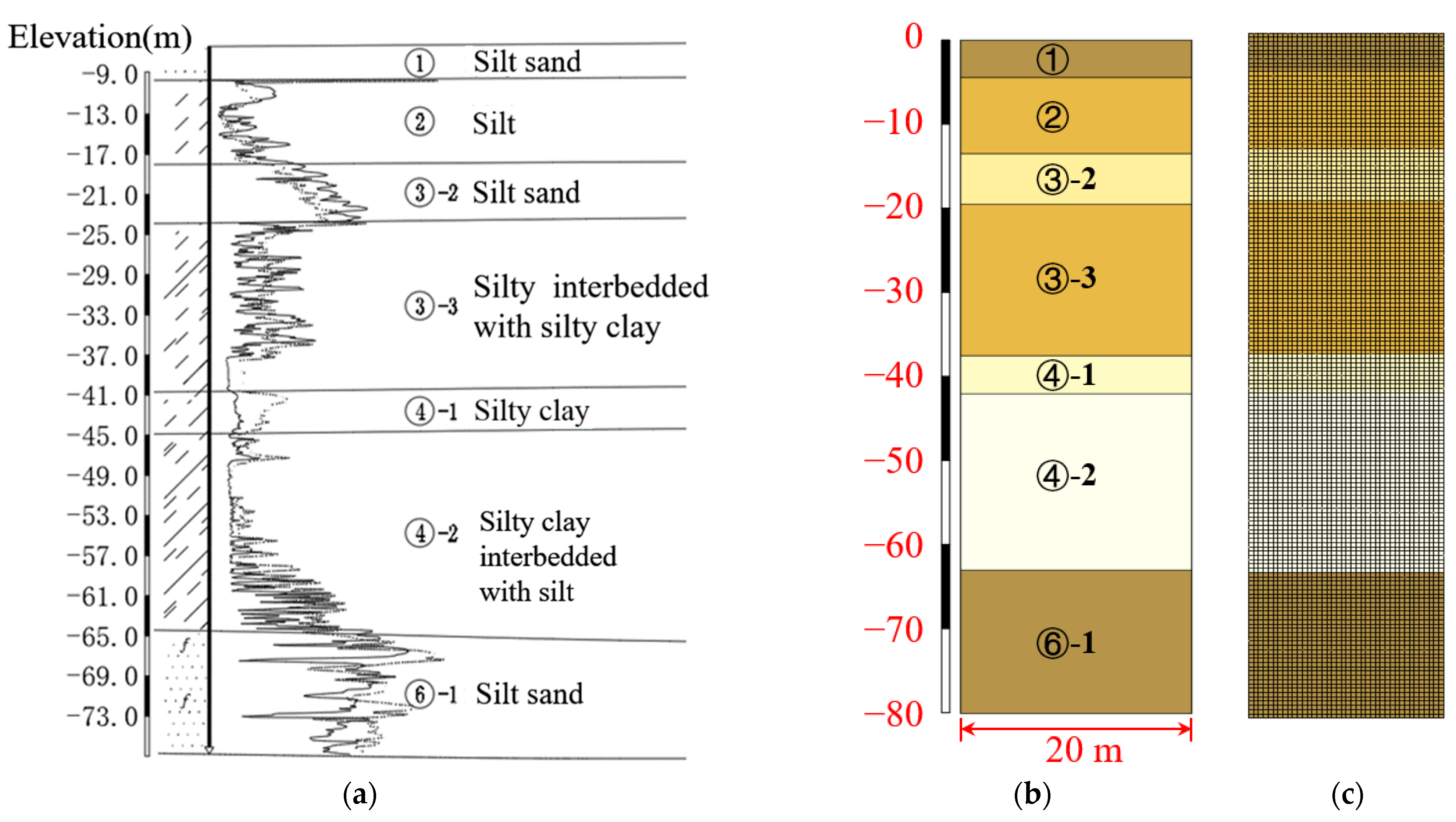
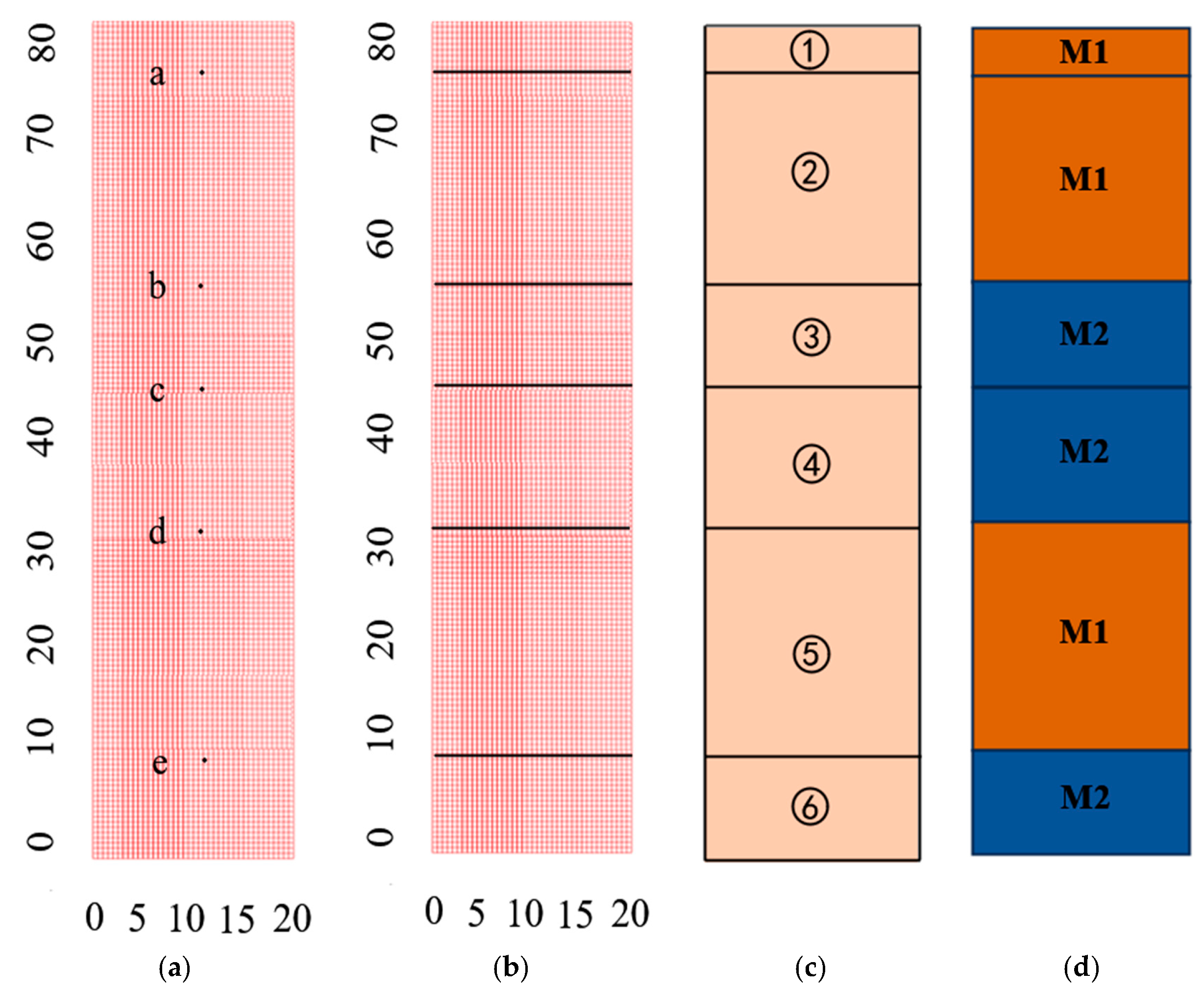




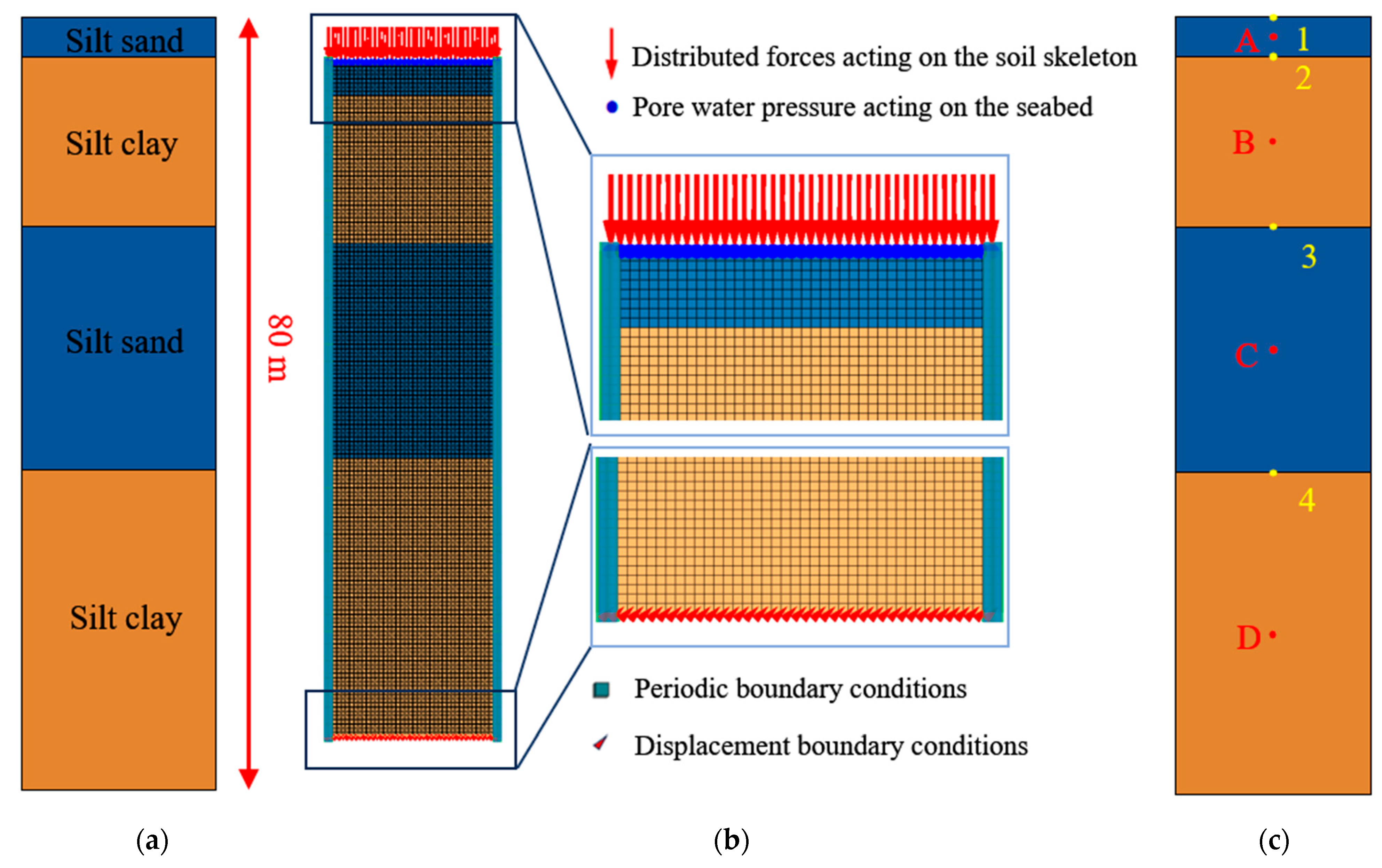

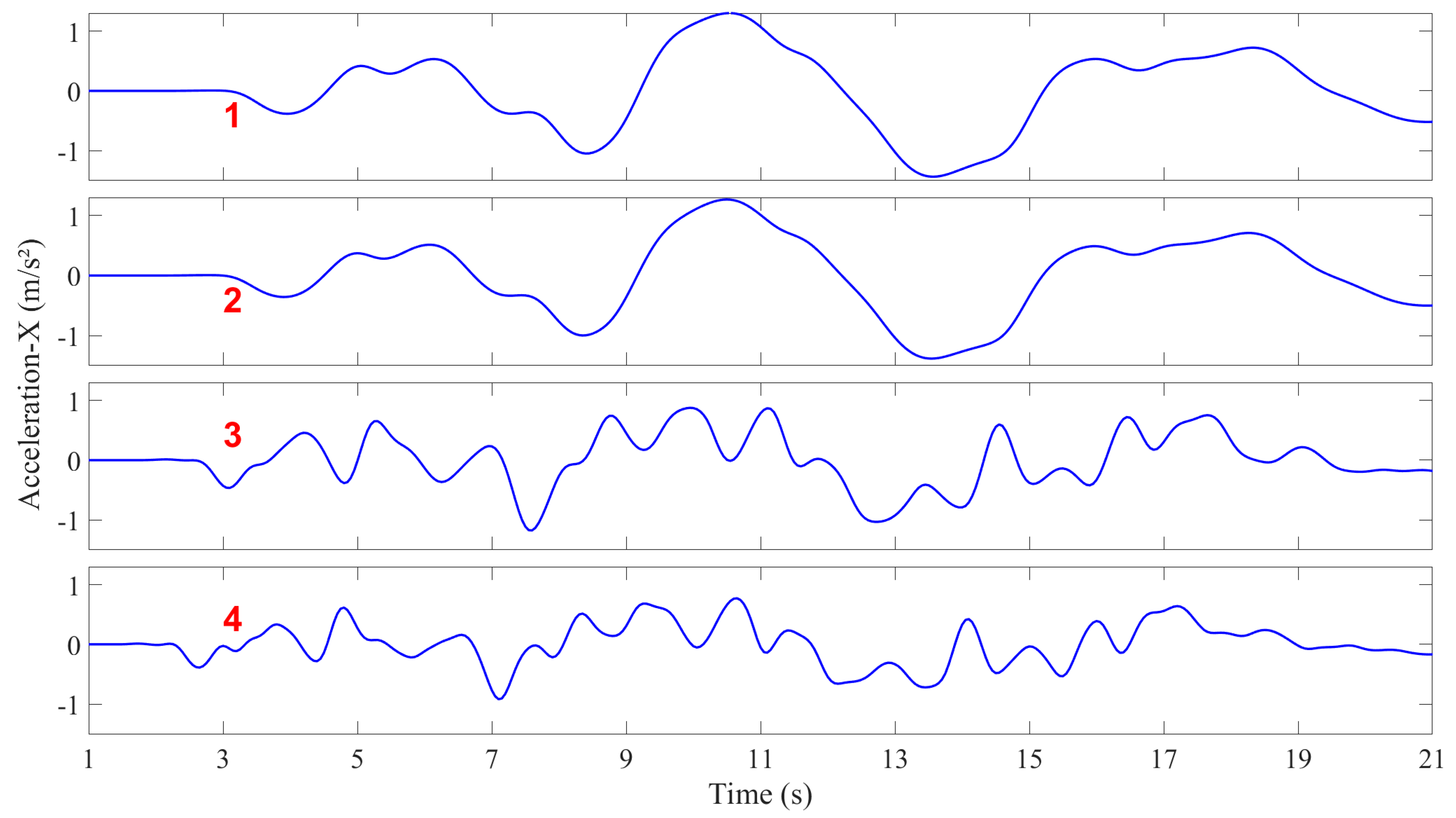
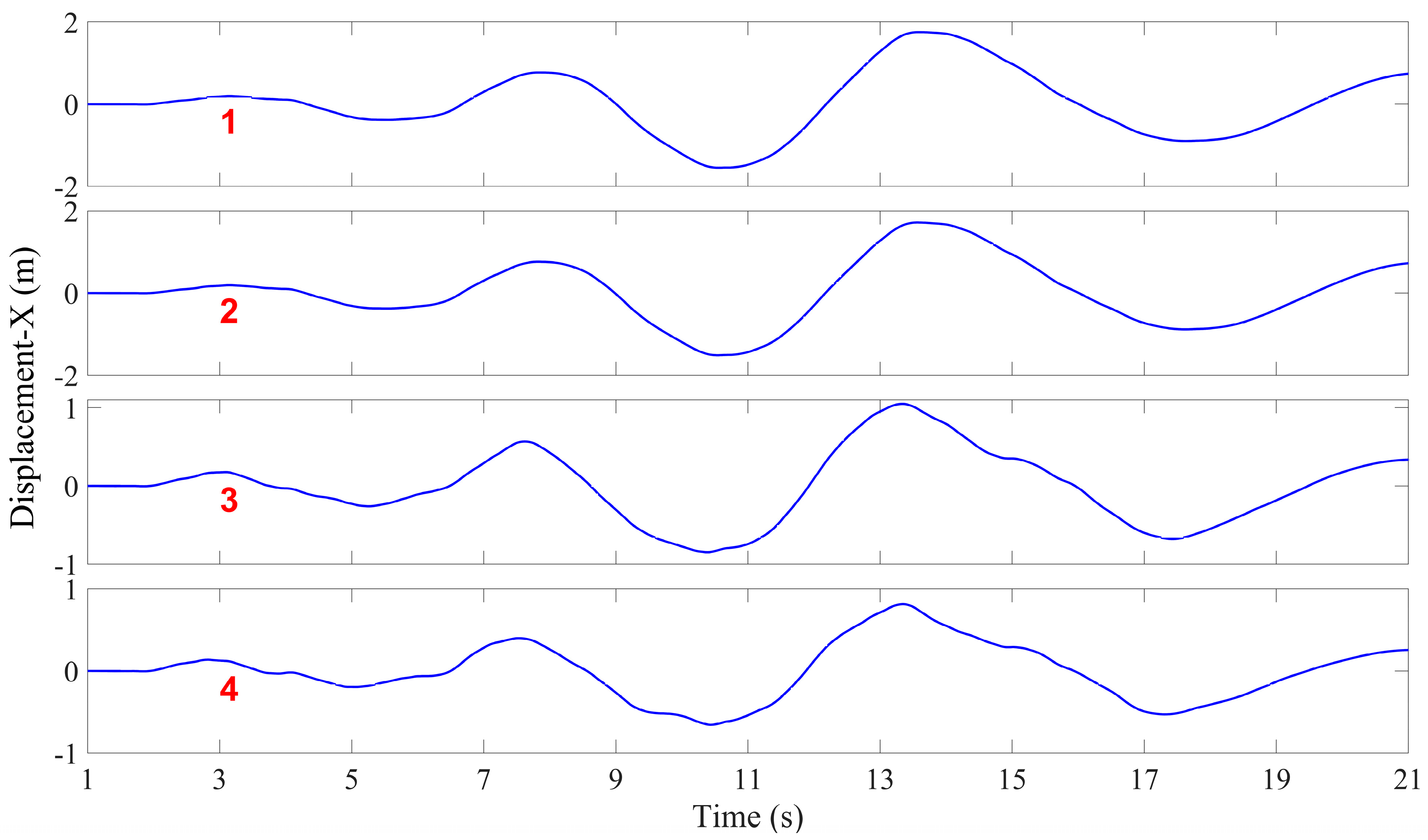
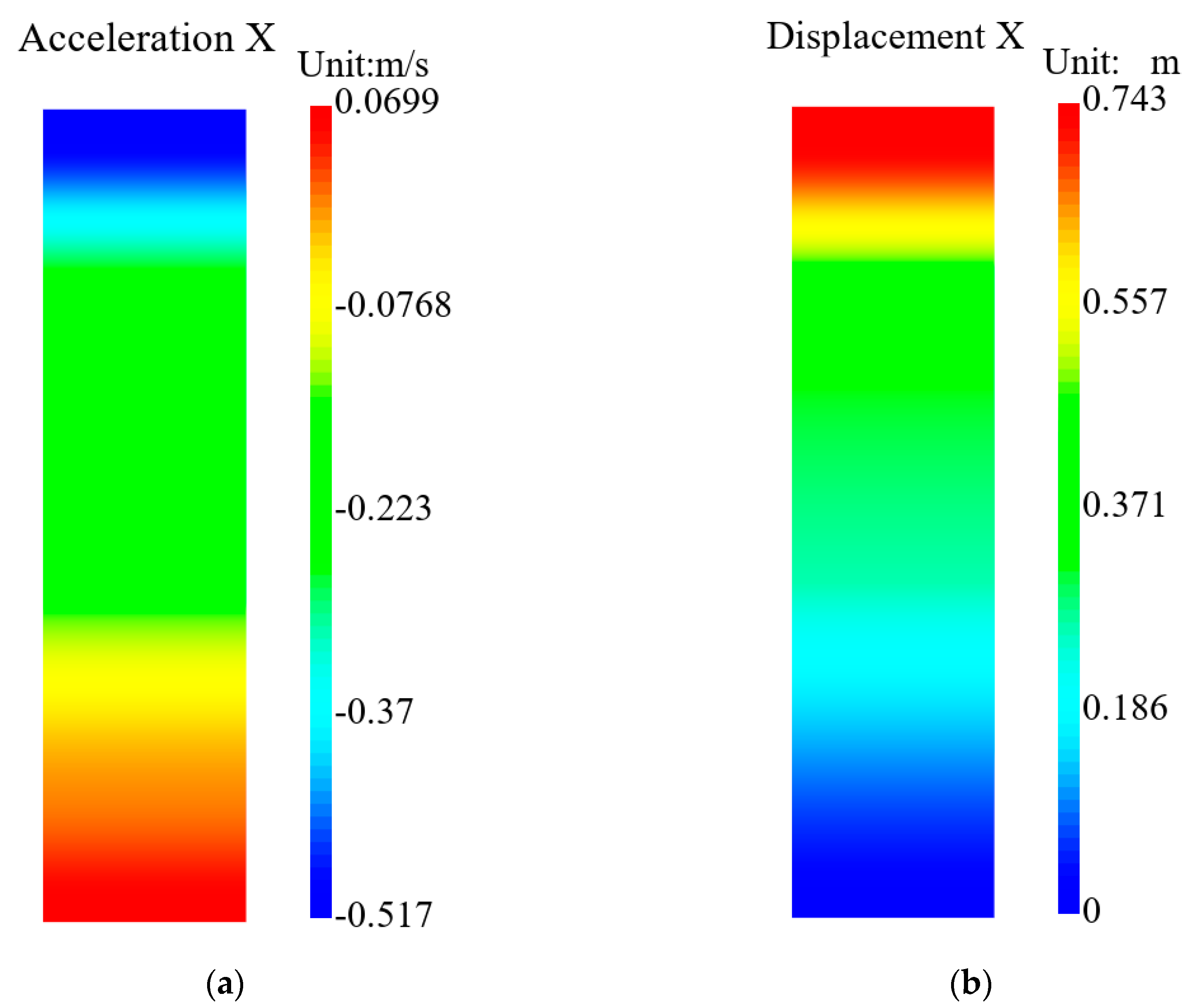

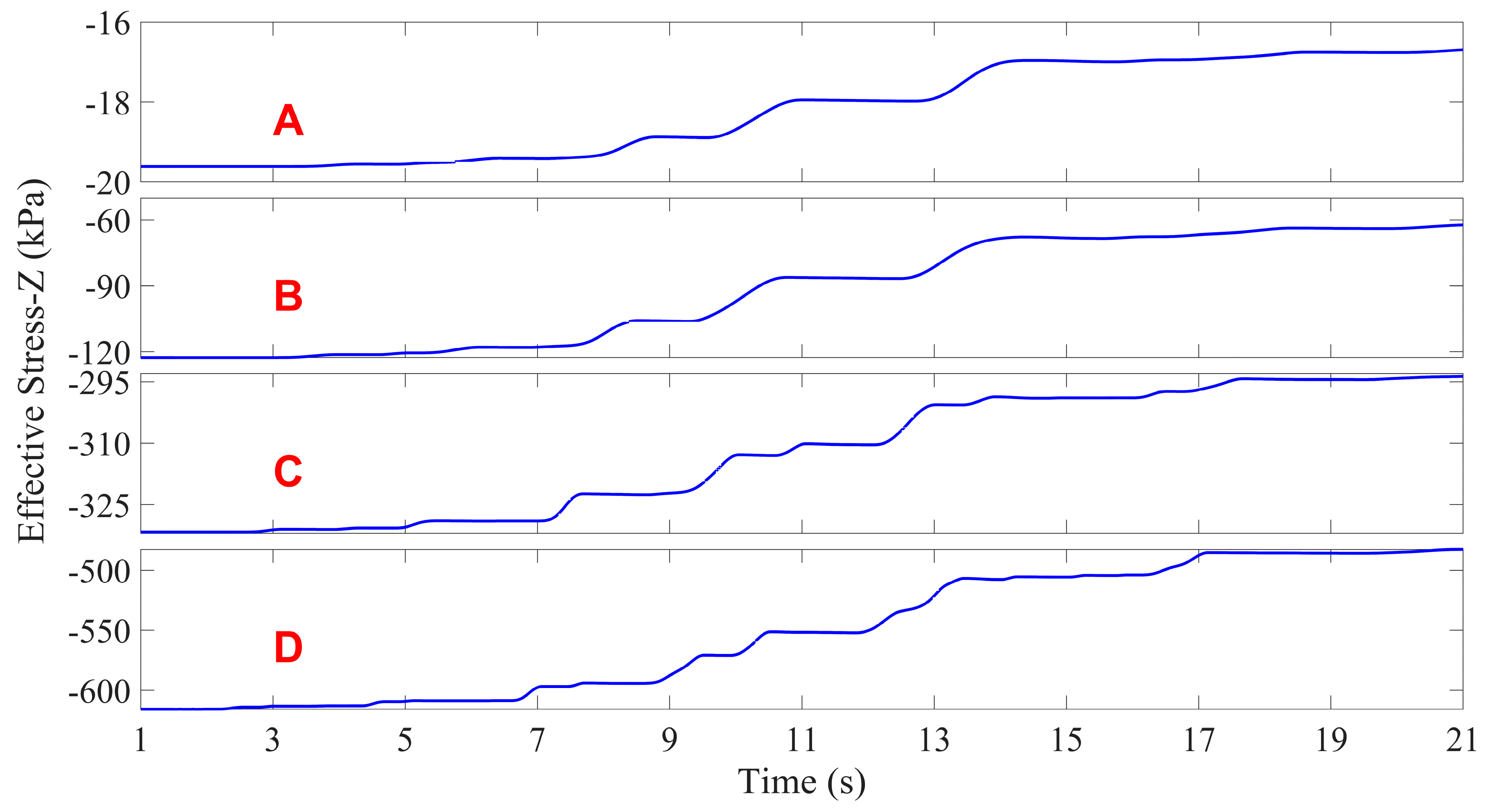
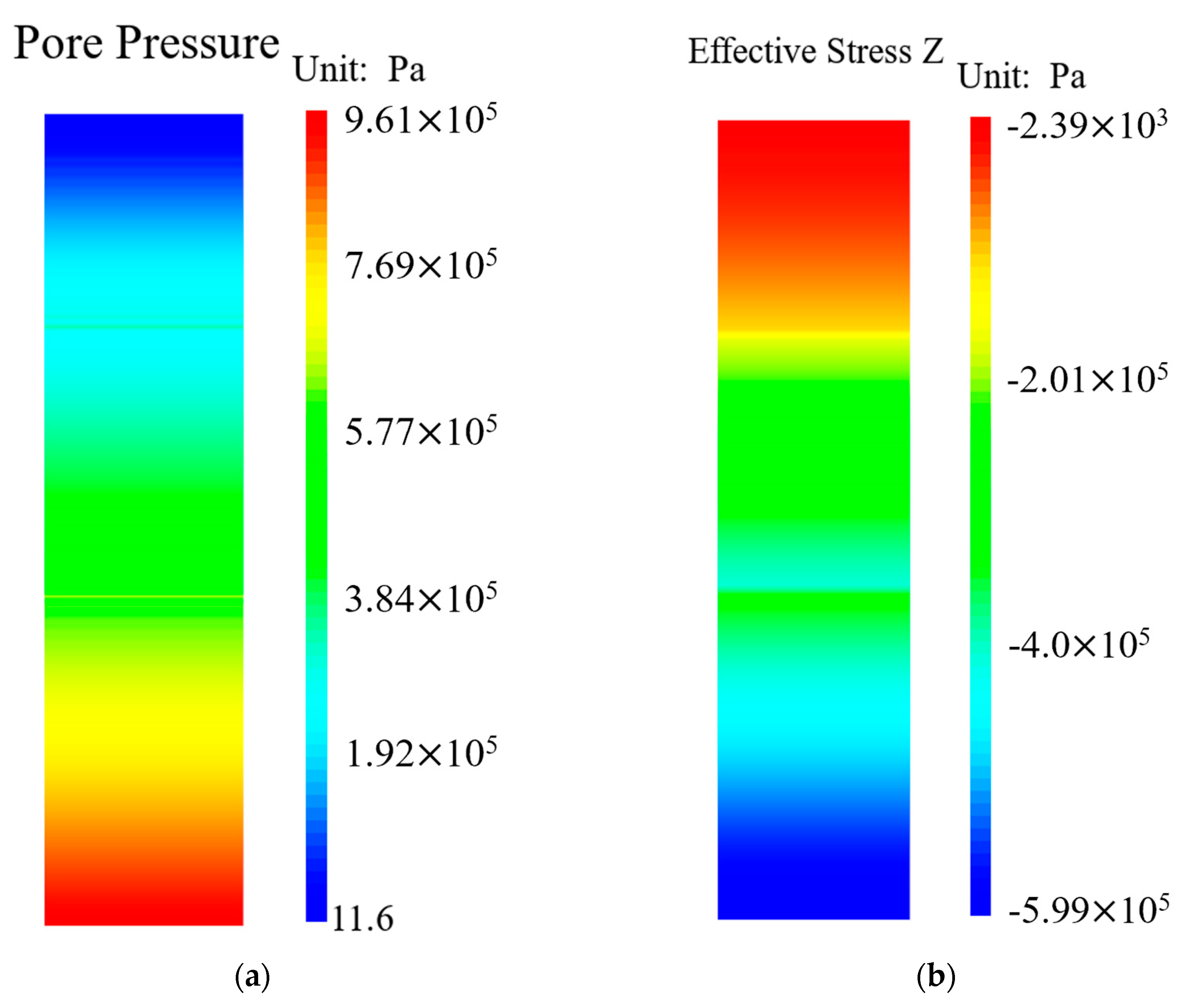
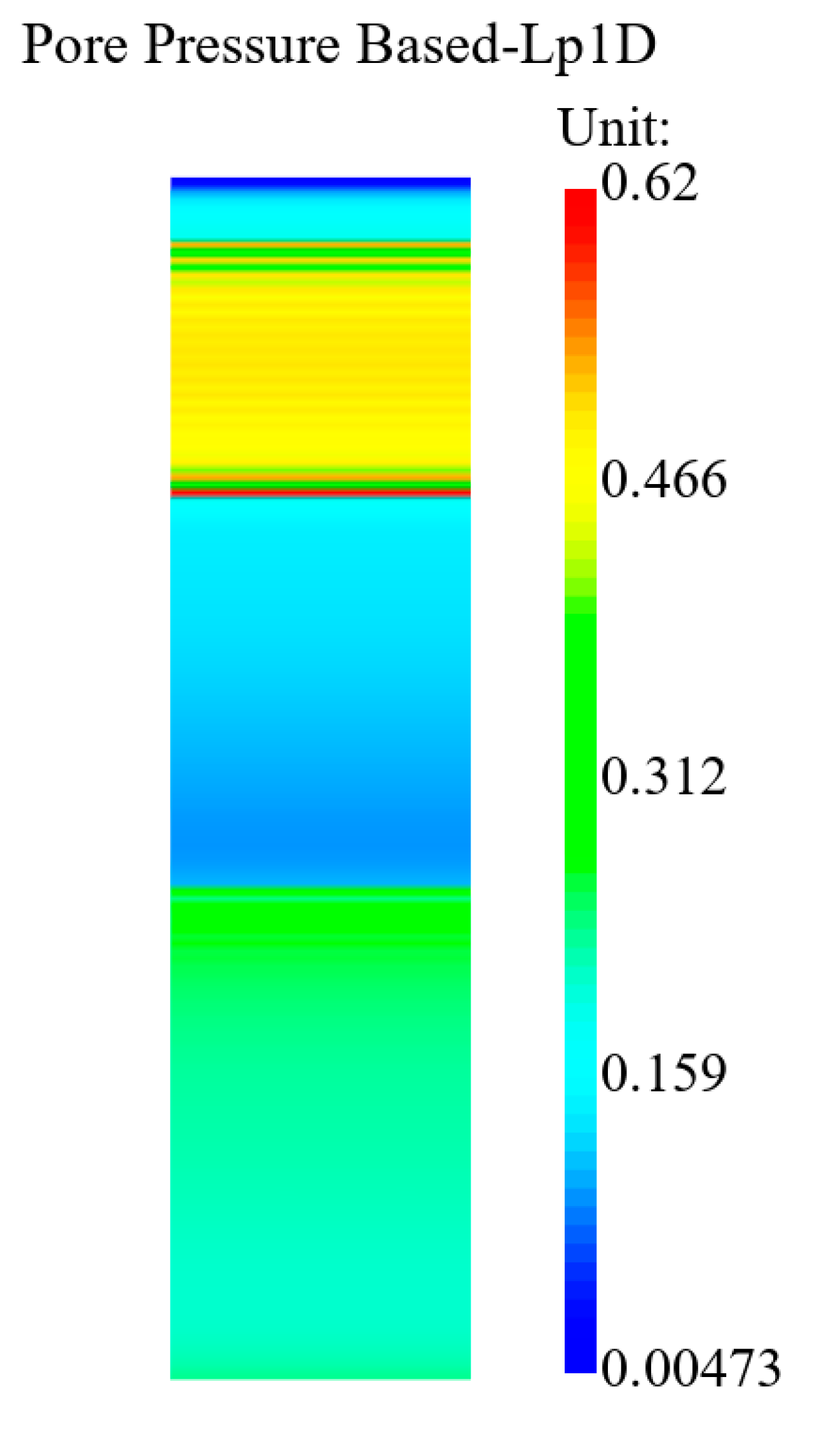
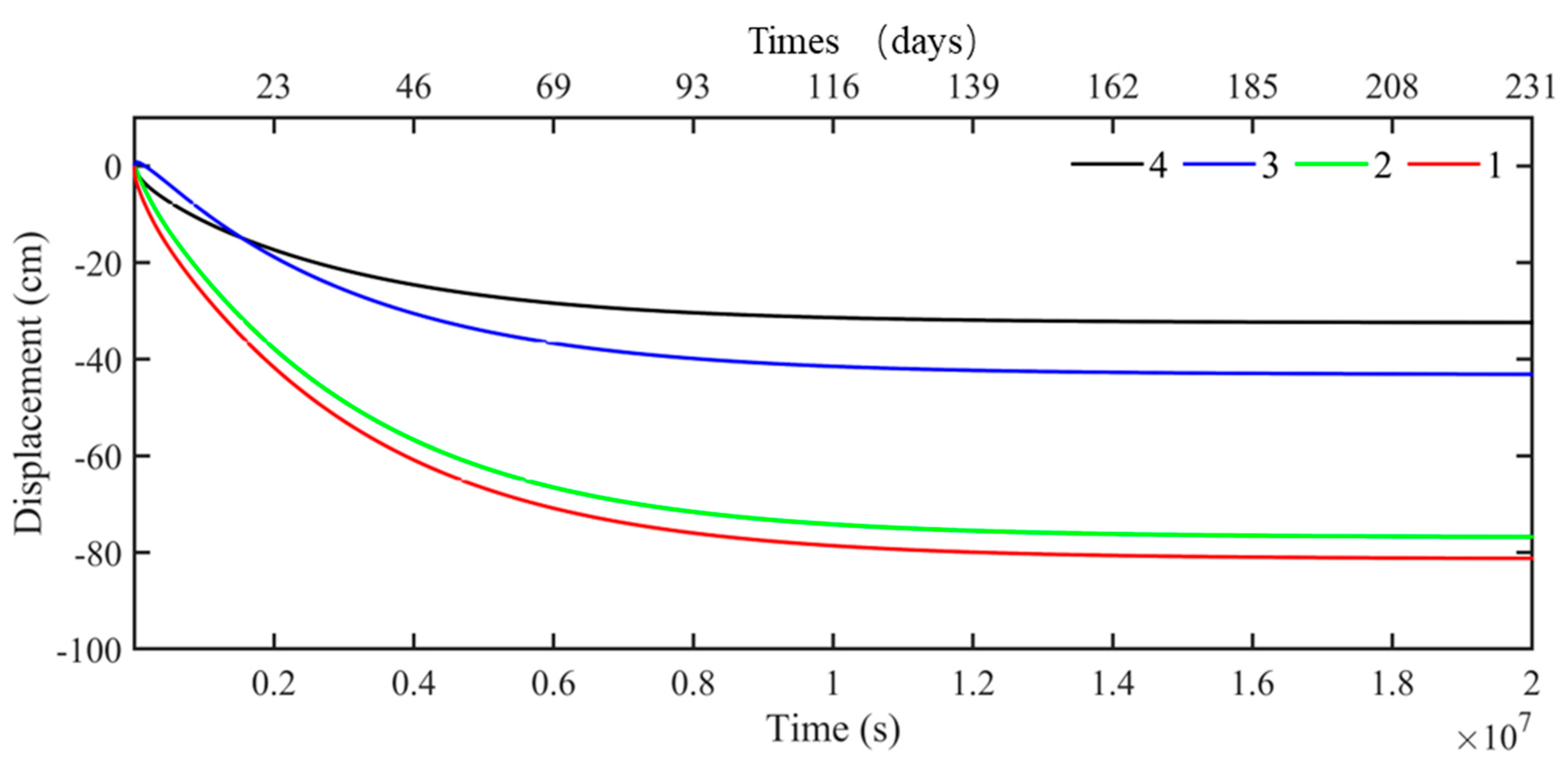
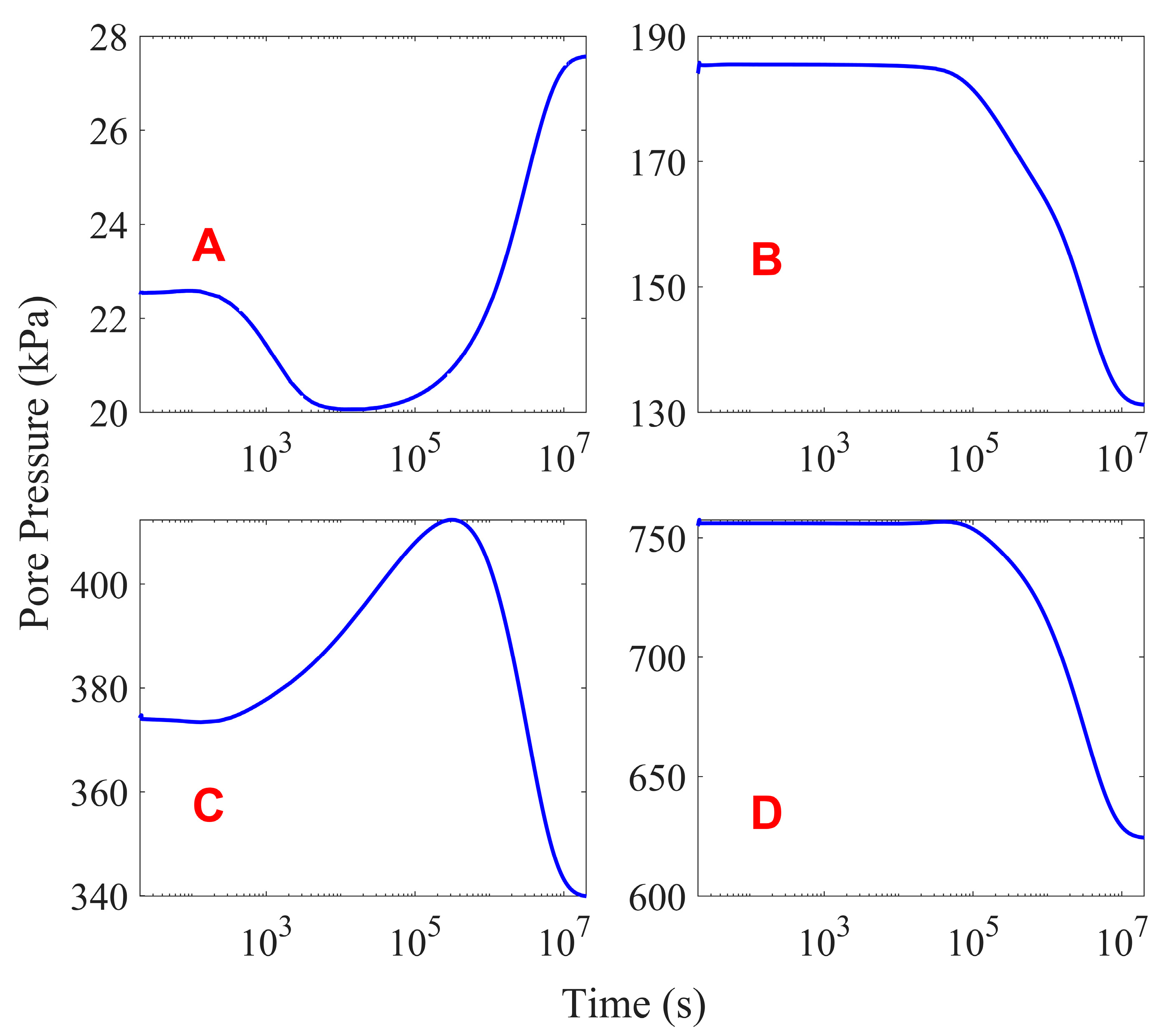

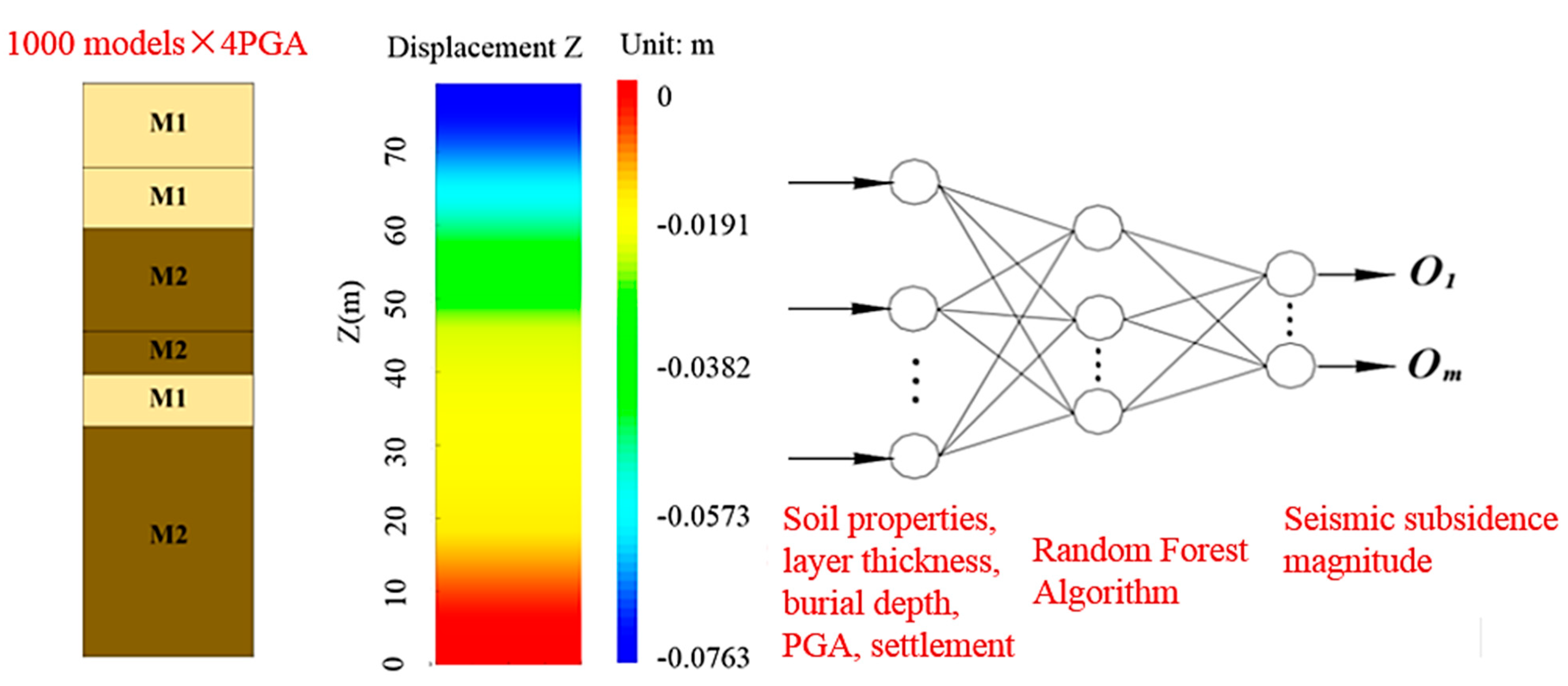
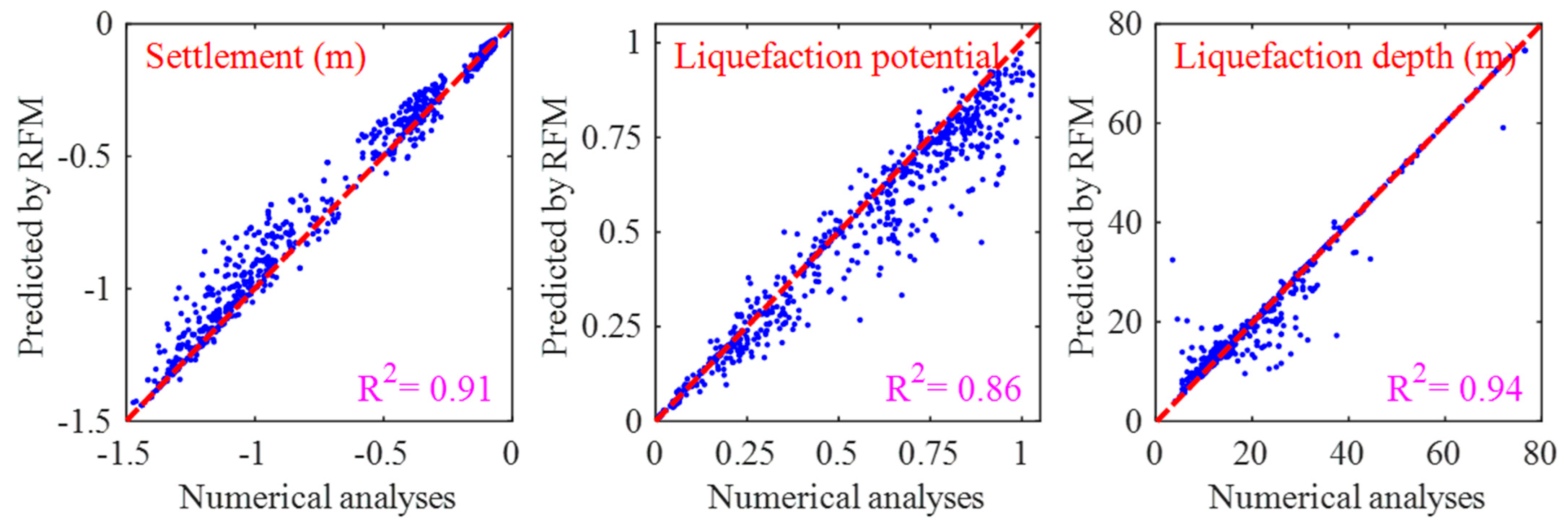

| Foundation Soil | Initial Void Ratio | Permeability Coefficient/(m·) | Compression Index λ | Rebound Index κ | Failure Stress Ratio | Cohesion/KPa | Internal Friction Angle/(°) |
|---|---|---|---|---|---|---|---|
| Sand | 0.728 | 0.011 | 0.001 | 1.25 | — | — | |
| Soft clay | 0.980 | — | — | — | 40 | 15 |
| K0/(Pa) | G0/(Pa) | Mg | αg | Mf | αf | β0 | β1 | H0 | Hu0/(Pa) | γDM | γu | |
|---|---|---|---|---|---|---|---|---|---|---|---|---|
| 2.092 × 106 | 1 × 108 | 1.25 | 0.45 | 0.95 | 0.45 | 4.2 | 0.2 | 442.14 | 442.1 × 103 | 1 | 1 | 1 × 103 |
| Normal Consolidation Line Slope λ | Rebound Modulus κ | Poisson’s Ratio ν | Critical State Stress Ratio M | Normal Consolidation Line Intercept N | Critical State Line Intercept Γ | Boundary Surface Model Parameters n |
|---|---|---|---|---|---|---|
| 0.14 | 0.043 | 0.38 | 1.25 | 1.13 | 1.00 | 1.60 |
| Site Category | Design Intensity | Peak Ground Acceleration (PGA) (g) | Characteristic Period (s) | Horizontal Influence Coefficient |
|---|---|---|---|---|
| II | VII–VIII | 0.05, 0.1, 0.2, 0.4 | 0.35 | 0.45 |
Disclaimer/Publisher’s Note: The statements, opinions and data contained in all publications are solely those of the individual author(s) and contributor(s) and not of MDPI and/or the editor(s). MDPI and/or the editor(s) disclaim responsibility for any injury to people or property resulting from any ideas, methods, instructions or products referred to in the content. |
© 2025 by the authors. Licensee MDPI, Basel, Switzerland. This article is an open access article distributed under the terms and conditions of the Creative Commons Attribution (CC BY) license (https://creativecommons.org/licenses/by/4.0/).
Share and Cite
Zhao, L.; Sun, M.; Ye, J.; Yang, F.; He, K. Characteristics and Rapid Prediction of Seismic Subsidence of Saturated Seabed Foundation with Interbedded Soft Clay–Sand. J. Mar. Sci. Eng. 2025, 13, 559. https://doi.org/10.3390/jmse13030559
Zhao L, Sun M, Ye J, Yang F, He K. Characteristics and Rapid Prediction of Seismic Subsidence of Saturated Seabed Foundation with Interbedded Soft Clay–Sand. Journal of Marine Science and Engineering. 2025; 13(3):559. https://doi.org/10.3390/jmse13030559
Chicago/Turabian StyleZhao, Liuyuan, Miaojun Sun, Jianhong Ye, Fuqin Yang, and Kunpeng He. 2025. "Characteristics and Rapid Prediction of Seismic Subsidence of Saturated Seabed Foundation with Interbedded Soft Clay–Sand" Journal of Marine Science and Engineering 13, no. 3: 559. https://doi.org/10.3390/jmse13030559
APA StyleZhao, L., Sun, M., Ye, J., Yang, F., & He, K. (2025). Characteristics and Rapid Prediction of Seismic Subsidence of Saturated Seabed Foundation with Interbedded Soft Clay–Sand. Journal of Marine Science and Engineering, 13(3), 559. https://doi.org/10.3390/jmse13030559






